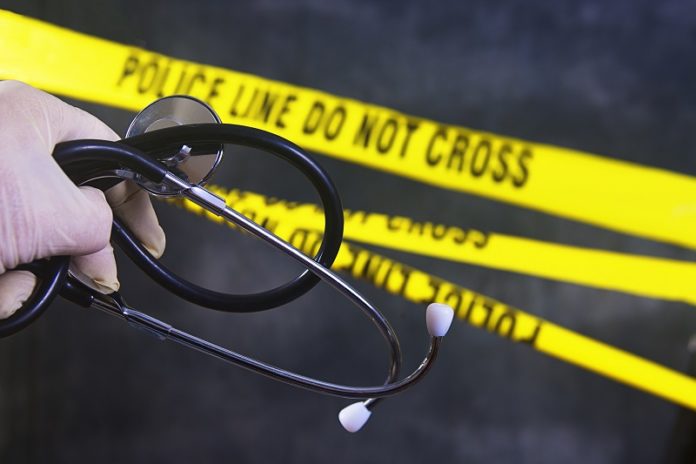If a shopper gets obnoxious and starts a fight in a store, the recourse is obvious.
Kick them out. Call the police. Or both.
If an angst-ridden patient, or their family, gets unruly in an emergency room — kicking, spitting, punching, pulling a knife or worse — the recourse is more difficult.
Physicians and nurses have an ethical obligation to treat the patients who come to them in pain, on alcohol or drugs, or suffering from an unchecked mental health condition.
They must work with the distressed families demanding immediate care for their daughters, sons, moms and dads who may be in dire need of seeing a physician.
It adds up to a potentially dangerous workplace for health care workers, who experience a disproportionate amount of nonfatal workplace violence in the United States.

“We cannot say no,” said Celina Popovich Huffman, nursing director for AdventHealth Shawnee Mission. “But I think also, we don’t want to say no.”
In a recent podcast with the Kansas Hospital Association, Huffman laid out the dilemma health care workers face as they treat patients while trying to keep themselves safe
“Every provider wants to take care of that patient, and I think that’s what makes this kind of a complex situation,” she said.
“We are going to continue to be in vulnerable situations even though we really want to provide the best care for our patients,” Huffman said.
For many physicians and nurses, coping with the potential for violence is part of the job, although it’s reaching proportions where something needs to be done, she said.
“I’d like to see some more accountability where it’s not OK to harm a health care worker,” Huffman said.
Kansas lawmakers are being asked to address the issue with a bill that would increase the penalties for violence against a health care provider. The bill puts it on the same level as interfering with a police officer, an emergency medical worker or a firefighter.

The bill creates the misdemeanor offenses of interference with the conduct of a hospital and battery against a health care workers.
“Violence in our hospitals has risen dramatically over the last handful of years and even more so during the pandemic,” said Democratic state Rep. Linda Featherston, who leads a bipartisan group of about 20 lawmakers supporting the bill.
Featherston hopes the bill will be a deterrent that will bring the level of violence by “holding people accountable for their actions.”
Examples of the types of violence against health care workers have been documented across the country. For instance:
- A nurse was attacked by a member of a patient’s family at about 11 p.m. Jan. 27 in a suburban New Orleans hospital. The nurse was injured and knocked unconscious, but the suspect fled before authorities arrived. No motive was known for the attack.
- A nurse at a Richland, Washington, hospital was choked in 2018 while trying to stop a 65-year-old patient from removing his intravenous line. The patient was charged with second-degree assault. The nurse relayed the incident on Facebook. “Let me tell you, having a strong individuals hands around your neck, the inability to breathe, let alone call for help, to the point where you can’t see a thing and can only hear an emergency ‘staff assist’ tone going off, is one of the absolutely gut-wrenching, most terrifying feelings anyone could ever imagine. It didn’t help that it was preceded with the words ‘I’m gonna kill you.’”
- A hospital nurse and security officer were attacked a couple weeks ago at a Burnsville, Minnesota, hospital. A 20-year-old man was booked into jail on charges of assault and damage to property. No other details were available.
- A patient at an Ogden, Utah, hospital was charged last year with assault after it was reported that he had groped several female nurses and assaulted a security officer and several male nurses during his hospital stay. Security video showed the man charging a female nurse when a male nurse stepped in to stop him. The man was seen trying to kick the male nurse as he held him back before the man tackled the nurse into a wall.
“Health care workers are exposed to different forms and degrees of violence each and every day they report to work,” Stormont Vail Emergency Room Director Morgan Gerhardt said in an email.
“The mental toughness that is required to be threatened, kicked, or spit at minutes before you’re being asked to save the life of another patient is unlike that of any other profession, and certainly not sustainable,” Gerhardt said.
The legislation comes at a time when violence against health care workers has been getting heightened attention and has become more pronounced during the pandemic.
Before the pandemic hit in 2020, the American College of Emergency Physicians reported that nearly 7 out of 10 emergency room doctors believed that violence was increasing.
More than 50% said that patients had been physically harmed while 47% of physicians said they were personally attacked at work.
The problem only worsened during the pandemic when hospitals were overrun by patients stricken with the COVID virus while hospitals suffered from staff shortages and turnover because of burnout.
A National Nurses United survey in late 2020 of more than 15, 000 registered nurses found that about 20% said they faced increased on-the-job violence, which they attributed to staffing shortages, changes in their patient population and restrictions for visitors.
Just last week, the president of the American Medical Association called for an end to threats and intimidation against physicians and other health care workers.
“Simply telling our colleagues in medicine to cope with harassment and menacing behavior is unacceptable,” Gerald E. Harmon wrote last week in an opinion piece.
“It is imperative that physicians and health professionals feel safe and secure, whether we’re caring for patients or working to advance equity on a broad scale in our communities.”
State across the country have been passing legislation in an effort to curb the violence. Consider these examples:
- Oregon is considering legislation would make it a crime of third-degree assault for intentionally, knowingly or recklessly physically injuring hospital workers performing duties. The punishment would be a maximum of five years in prison, a $125,000 fine, or both. Currently, the cime is a misdemeanor.
- The Utah House just passed a bill last week that increase the penalties for attacks on doctor and nurses.The bill now heads to the Senate for consideration.
- Two bills have been introduced in Michigan that get tough health care worker violence. One bill creates a misdemeanor for assaults against an emergency room worker while undertaking their official duties. A person who assaults an emergency room worker without a weapon and inflicts serious harm without the intent to kill would be punishable to a maximum one year in prison, a $2,000 fine, or both. A person who assaults an emergency room worker with a dangerous weapon without the intent to murder could receive up to four years in prison, a $4,000 fine, or both.
Violence against health care workers is not new, although it’s been rising steadily over the last decade, federal data shows.
The number of nonfatal violent incidents and illnesses involving health care workers nationally rose from 8,180 in 2011 to 15,230 in 2018, according to the Bureau of Labor Statistics.
The number of violent incidents and illnesses involving health care workers made up 73% all incidents and illnesses in the workplace in 2018, federal data shows.
“The health care and social service industries experience the highest rates of injuries caused by workplace violence and are 5 times as likely to suffer a workplace violence injury than workers overall,” the Bureau of Labor Statistics reported.
The Kansas Hospital Association surveyed 251 individuals at 109 Kansas hospitals and clinics, with a majority of responses coming from critical access hospitals.
The 2019 survey found that 46.2% said patients, visitors or others commit acts of workplace violence at least one to three times a year.
About 21% said there were violent incidents one to three times a month, and nearly 13% said they occurred one to three times a week.
About 64% of those surveyed said their facilities were very safe or safe, compared to about 36% who thought they worked in unsafe or very unsafe conditions.
The cause of violence? Hospital workers were asked to list the three most important causes contributing to workplace violence.
About 32% said drugs and alcohol, followed by behavioral health at 27.6% and general incivility at 14%. Family members were seen as a contributing cause by 13.6%.
While the Kansas Hospital Association survey and national statistics may be instructive, they probably don’t document the entire scope of the problem.
Health care workers tend not to report workplace violence for any number of reasons, including a fear of retaliation by the employer or the offender, lack of a clear reporting method and the view that nothing will be done about it, according to a 2019 report by the American Nurses Association.
“Often times, we know it’s under reported because they’re not reporting violence in the work place because that’s just part of the job,” said Cindy Samuelson, senior vice president for the Kansas Hospital Association.

“For many of them, they’ve taken an oath to serve and to do that and they feel that physical and mental anguish is part of that,” Samuelson said.
“There’s been a lot of education that we’ve had to do on that other side of the coin to make sure people working in health care know that they’re not there to be beat up,” she said.
A 2016 GAO study found a number of studies showed that percentage of cases that were formally reported ranged from 7% to 42%.
The GAO report found that the lack of reporting stemmed from a lack of health care workers not suffering serious injuries, inconvenience and the perception that violence comes with the job.
Nevertheless, it’s a threat that constantly lives in the minds of health care workers and their supervisors.
“My team’s safety is what keeps me up at night. Their mental health is what keeps me up at night,” Stormont Vail’s Gerhardt said.
“And no metal detector or wanding procedure will ever lessen the fear our team feels when encountering violent patients.
“While the risk of violence is there for health care workers every day,” she said, “that doesn’t stop our team from doing our very best to provide care to our patients.”















